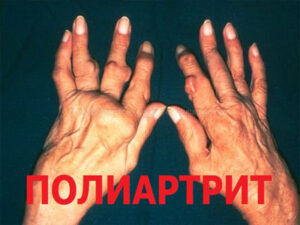SHARE WITH FRIENDS:
POLYARTHRITIS is a chronic inflammation of the joints, characterized by sudden or successive damage. Because polyarthritis develops for a variety of reasons, the clinical signs also vary. The only sign that unites them is inflammation of the joint membrane - the synovial layer.
Causes of polyarthritis
• Infectious processes: tuberculosis, gonorrhea;
• Genetic predisposition;
• Unhealthy lifestyle;
• Malnutrition;
• Metabolic disorders;
• Injuries, bruises.
Types and course of polyarthritis.
1. Rheumatoid polyarthritis - occurs mainly with damage to the small joints of the palms of the hands and feet. The disease then affects the internal organs (heart, blood vessels, kidneys). Rheumatoid polyarthritis is characterized by enlargement of the synovial membrane and blood vessels, followed by disruption of the joint and deformation of the joint.
2. Infectious polyarthritis - develops as a result of infectious processes such as tuberculosis, gonorrhea and brucellosis, ORVI, measles, mumps, whooping cough, viral hepatitis. If the underlying disease is treated, it will pass quickly.
3. Crystalline polyarthritis - develops as a result of metabolic disorders in the body and is accompanied by the deposition of crystals of urate salts in the joints. These crystals affect the joints and cause inflammation. It is mainly found in people who eat fatty, meaty, smoked foods and consume alcohol.
4. Psoriatic polyarthritis - develops 6-8 months after suffering from psoriasis. It is mainly found in people under 40 years of age with damaged joints.
5. Reactive polyarthritis - develops as a result of various infections entering the lungs and urinary system. Symptoms of conjunctivitis, polyneuritis and colitis are observed.
6. Posttraumatic polyarthritis - develops as a result of bruising, sprains, cracks in the joints and microtraumas.
Polyarthritis clinic
1. Rheumatoid arthritis - first irritated only when the air is clear, then there is a slight swelling, pain in the joints, redness of the skin around the joint, an increase in local temperature. As the disease progresses, there is an increase in pain, limb congestion, morning numbness. In rheumatic polyarthritis, the joints are affected symmetrically.
2. Infectious polyarthritis - redness and swelling of the skin over the affected joint, limited joint movement.
3. Crystalline polyarthritis - if the pain in the joints is first observed in their specific condition, the pain becomes chronic as a result of the proliferation of crystals. It mainly affects the big toe and is accompanied by the appearance of gouty nodules on the skin - tofus.
4. Psoriatic polyarthritis - pain in the joints and limited mobility, especially in the morning and after a long rest.
5. Reactive polyarthritis - pain and swelling of the toes, elbows and knees of the feet. Inflammation of the prostate and urethra in men and uterus and vagina in women is also added.
6. Posttraumatic polyarthritis is a constant tension pain in the joints and muscles, which is accompanied by tightness when moving them.
Treatment of polyarthritis
Drug treatment focuses on relieving pain and treating inflammation. For this purpose, analgesic and nonsteroidal anti-inflammatory drugs are given. These medications also treat symptoms such as joint swelling, irritation, and tingling.
Antibiotics are prescribed in infectious and reactive polyarthritis. Treatment is aimed at eliminating the source of infection.
Immunodepressants and hormonal drugs are given to treat rheumatoid polyarthritis.
In crystalline polyarthritis, drugs that reduce the amount of uric acid in the body and improve the metabolic process are used. Physiotherapeutic treatments include massage and therapeutic gymnastics, ultrasound therapy and electrophoresis with drugs, paraffin therapy and ozokerite therapy, barotherapy and magnetotherapy.
Therapeutic therapies are carried out in the spring - autumn, when the disease is in full swing. A separate place is taken by sanatorium-spa treatment, mineral waters, natural healing muds, underwater massages.
© https://t.me/gepamed_ultra
hepamed.uz
